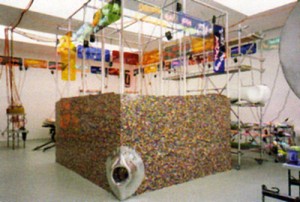For ‘Tema Celeste’ magazine

Cod Canal. The Flounder. Fish Hole. Tuna Town. These phrases and hundreds more were spelled out in bright, neon lights high on the walls of David Zwirner’s gallery. At first, aided by an enormous, multicolored cube-shaped construction made entirely of lego, they created a festive atmosphere. The show seemed dazzlingly fun, at least until the artist’s symbolism was decoded. The seductively colorful lights in fact spelled out mostly derogatory slang terms for vagina, and were joined by less ambiguous words like “wound,” “monster” and “cum dumpster.” With a little explanation, the show flipped from impressive to oppressive.
The title, Meccatuna, summarized two competing trains of thought. First, Mecca—the home of the cube shaped Ka’ba considered by Muslims to be the center of the world—is represented in the show by the lego structure. Second, tuna—slang term for vagina—is symbolized by the neon words arranged on the walls and on metal shelving units, shiny metal disk sculptures, tires, and sculptures in the shape of a camel’s toe bone. Mecca and tuna are united in the narrative of a journey commissioned by Rhoades, who supposedly paid a man in Saudi Arabia to document the purchase of a box of Geisha brand tuna in Mecca.
The artist’s conceptual starting points are clear, but they initiate disturbing chains of association. His primary comparison is between the Muslim center of the world and the vagina as L’Origine du monde, as Courbet titled his famous painting. East also meets West in the donkey and camel, submissive beasts of burden and secondary actors in Rhoades’ tableau. Does this designation extend to women, whose vaginas are represented by the camel in this show? How are we to read a photograph on the gallery wall of the Ka’ba, surrounded by circumambulating worshippers? The relationship between animals, the faithful and women are too undefined; Rhoades may not have intended to directly insult women and Muslims, but his practice of encouraging ambiguous associations backfires in Meccatuna. Provocation for its own sake is like a drum roll followed by nothing—attention grabbing but ultimately disappointing.